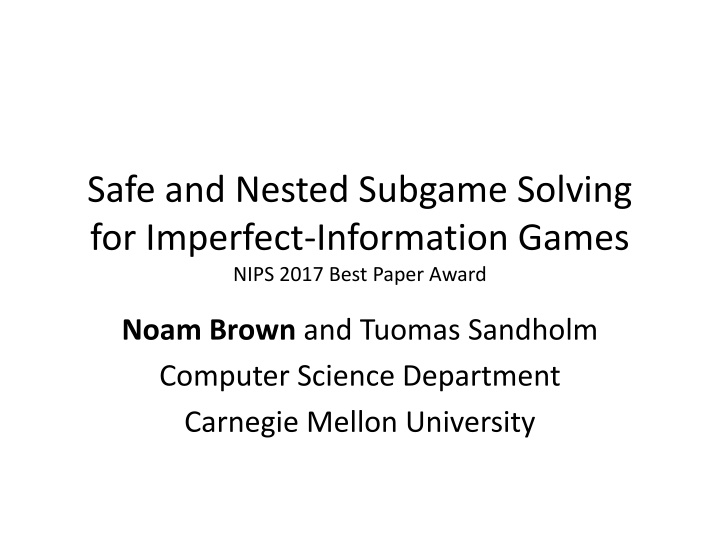
Nested Subgame Solving for Imperfect-Information Games
Discover the intricate strategies behind imperfect-information games like Poker, Chess, and Military campaigns. Learn about Nash Equilibrium and techniques like AlphaGo in this exploration of game theory.
Download Presentation

Please find below an Image/Link to download the presentation.
The content on the website is provided AS IS for your information and personal use only. It may not be sold, licensed, or shared on other websites without obtaining consent from the author. If you encounter any issues during the download, it is possible that the publisher has removed the file from their server.
You are allowed to download the files provided on this website for personal or commercial use, subject to the condition that they are used lawfully. All files are the property of their respective owners.
The content on the website is provided AS IS for your information and personal use only. It may not be sold, licensed, or shared on other websites without obtaining consent from the author.
E N D
Presentation Transcript
Safe and Nested Subgame Solving for Imperfect-Information Games NIPS 2017 Best Paper Award Noam Brown and Tuomas Sandholm Computer Science Department Carnegie Mellon University
Imperfect-Information Games Military Financial markets (spending, allocation) Chess Go Poker Negotiation Security (Physical and Cyber) Political campaigns
AlphaGo AlphaGo techniques extend to all perfect-information games
Example Game: Coin Toss P1 Information Set P1 Information Set C P1 P1 P2 Information Set P2 P2 -1 1 -1 1
Nash Equilibrium Nash Equilibrium: a profile of strategies in which no player can improve by deviating In two-player zero-sum games, playing a Nash equilibrium ensures the opponent can at best tie in expectation.
Imperfect-Information Games: Coin Toss C Imperfect-Information Subgame P1 P1 P2 P2 -1 1 -1 1
Imperfect-Information Games: Coin Toss C P1 P1 P2 P2 -1 1 -1 1
Imperfect-Information Games: Coin Toss Heads EV = 0.5 Tails EV = 1.0 Average = 0.75 C P1 P1 P2 P2 -1 1 -1 1
Imperfect-Information Games: Coin Toss C P1 P1 P2 P2 -1 1 -1 1
Imperfect-Information Games: Coin Toss Heads EV = 1.0 Tails EV = -0.5 Average = 0.25 C P1 P1 P2 P2 -1 1 -1 1
Imperfect-Information Games: Coin Toss C P1 P1 P2 P2 -1 1 -1 1
Imperfect-Information Games: Coin Toss Heads EV = 0.5 Tails EV = -0.5 Average = 0.0 C P1 P1 P2 P2 -1 1 -1 1
Imperfect-Information Games: Coin Toss C P1 P1 P2 P2 -1 1 -1 1
Imperfect-Information Games: Coin Toss C P1 P1 P2 P2 -1 1 -1 1
Imperfect-Information Games: Coin Toss C P1 P1 P2 P2 -1 1 -1 1
Solving the Whole Game Rhode Island Hold em: 109 decisions Solved with lossless compression and linear programming [Gilpin & Sandholm 2005] Limit Texas Hold em: 1013 decisions Essentially solved with Counterfactual Regret Minimization+ [Zinkevich et al. 2007, Bowling et al. 2015, Tammelin et al. 2015] Required 262TB compressed to 11TB No-Limit Texas Holdem: 10161 decisions Way too big
Abstraction[Gilpin & Sandholm EC-06, J. of the ACM 2007] Original game Abstracted game Automated abstraction 10161 Custom equilibrium-finding algorithm Reverse mapping ~equilibrium equilibrium Foreshadowed by Shi & Littman 01, Billings et al. IJCAI-03
Action Abstraction P1 P2 P2 P2 . . . . . . . . . . . .
Action Abstraction P1 P2 P2 P2 . . . . . . . . . . . . [Gilpin et al. AAMAS-08] [Hawkin et al. AAAI-11 AAAI-12] [Brown & Sandholm AAAI-14]
Action Translation P1 P2 P2 P2 . . . . . . . . . . . . [Gilpin et al. AAMAS-08] [Schnizlein et al. IJCAI-09] [Ganzfried & Sandholm IJCAI-13]
Card Abstraction [Johanson et al. AAMAS-13, Ganzfried & Sandholm AAAI-14] Best Hand: Grouped together
Libratus Abstraction 1st and 2nd round: no card abstraction, dense action abstraction 3rd and 4th round: card abstraction, sparse action abstraction Helps reduce exponential blowup Total size of abstract strategy: ~50TB
Subgame Solving [Burch et al. AAAI-14, Moravcik et al. AAAI-16, Brown & Sandholm NIPS-17]
Subgame Solving [Burch et al. AAAI-14, Moravcik et al. AAAI-16, Brown & Sandholm NIPS-17]
Subgame Solving [Burch et al. AAAI-14, Moravcik et al. AAAI-16, Brown & Sandholm NIPS-17]
Coin Toss C P1 P1 P2 P2 -1 1 -1 1
Blueprint Strategy C P1 P1 P2 P2 -1 1 -1 1
Unsafe Subgame Solving [Ganzfried & Sandholm AAMAS 2015] Assume the opponent plays according to the trunk strategy This gives a belief distribution over states Update beliefs via Bayes Rule 50% Probability 50% Probability C P1 P1 P2 P2 -1 1 -1 1
Unsafe Subgame Solving [Ganzfried & Sandholm AAMAS 2015] Assume the opponent plays according to the trunk strategy This gives a belief distribution over states Update beliefs via Bayes Rule C P1 P1 27% Probability 73% Probability P2 P2 -1 1 -1 1
Unsafe Subgame Solving [Ganzfried & Sandholm AAMAS 2015] Assume the opponent plays according to the trunk strategy This gives a belief distribution over states Update beliefs via Bayes Rule C P1 P1 27% Probability 73% Probability P2 P2 -1 1 -1 1
Unsafe Subgame Solving [Ganzfried & Sandholm AAMAS 2015] Create an augmented subgame that contains the subgame and a few additional nodes In the augmented subgame, chance reaches one of the subgame roots with probability proportional to both players playing the blueprint strategy Blueprint Strategy Augmented Subgame C P1 P1 C EV = -0.5 EV = 0.5 P2 P2 P2 P2 -1 1 -1 1 1 1 -1 -1
Subgame Resolving [Burch et al. AAAI 2014] In the augmented subgame, chance reaches one of the subgame roots with probability proportional to P1 attempting to reach the subgame, and P2 playing the blueprint. P1 then chooses between actions: Enter: Enter the subgame, proceed normally thereafter Alt: Take the EV (at this P1 infoset) of playing optimally against P2 s blueprint subgame strategy Blueprint Strategy C P1 P1 EV = -0.5 EV = 0.5 P2 P2 -1 1 1 -1
Subgame Resolving [Burch et al. AAAI 2014] In the augmented subgame, chance reaches one of the subgame roots with probability proportional to P1 attempting to reach the subgame, and P2 playing the blueprint. P1 then chooses between actions: Enter: Enter the subgame, proceed normally thereafter Alt: Take the EV (at this P1 infoset) of playing optimally against P2 s blueprint subgame strategy Blueprint Strategy Augmented Subgame C C P1 P1 P1 P1 EV = -0.5 EV = 0.5 -0.5 0.5 P2 P2 P2 P2 -1 1 -1 1 1 1 -1 -1
Subgame Resolving [Burch et al. AAAI 2014] In the augmented subgame, chance reaches one of the subgame roots with probability proportional to P1 attempting to reach the subgame, and P2 playing the blueprint. P1 then chooses between actions: Enter: Enter the subgame, proceed normally thereafter Alt: Take the EV (at this P1 infoset) of playing optimally against P2 s blueprint subgame strategy Blueprint Strategy Augmented Subgame C C P1 P1 P1 P1 EV = -0.5 EV = 0.5 -0.5 0.5 EV = 1.0 EV = -1.0 P2 P2 P2 P2 -1 1 -1 1 1 1 -1 -1
Subgame Resolving [Burch et al. AAAI 2014] In the augmented subgame, chance reaches one of the subgame roots with probability proportional to P1 attempting to reach the subgame, and P2 playing the blueprint. P1 then chooses between actions: Enter: Enter the subgame, proceed normally thereafter Alt: Take the EV (at this P1 infoset) of playing optimally against P2 s blueprint subgame strategy Blueprint Strategy Augmented Subgame C C P1 P1 P1 P1 EV = -0.5 EV = 0.5 -0.5 0.5 EV = 0.5 EV = -0.5 P2 P2 P2 P2 -1 1 -1 1 1 1 -1 -1
Subgame Resolving [Burch et al. AAAI 2014] Theorem: Resolving will produce a strategy with exploitability no higher than the blueprint Why not just use the blueprint then? Don t need to store the entire subgame strategy. Just store the root EVs and reconstruct the strategy in real time Guaranteed to do no worse, but may do better!
Subgame Resolving [Burch et al. AAAI 2014] Question: Why set the value of Alt according to the Play subgame? Why not to the Sell subgame? Answer: If P1 chose the Sell action, we would have applied subgame solving to the Sell subgame, so the P1 EV for Sell would not be what the blueprint says. Resolving guarantees the EVs of a subgame will never increase. Blueprint Strategy Augmented Subgame C C P1 P1 P1 P1 EV = -0.5 EV = 0.5 -0.5 0.5 EV = 0.5 EV = -0.5 P2 P2 P2 P2 -1 1 -1 1 1 1 -1 -1
Reach Subgame Solving [Brown & Sandholm NIPS 2017] Blueprint Strategy C P1 P1 EV = 0.5 EV = -0.5 C C P2 P2 P2 P2 -1 1 1 -1 -1 1 1 -1
Reach Subgame Solving [Brown & Sandholm NIPS 2017] Blueprint Strategy C P1 P1 EV = 0.5 EV = -0.5 C C P2 P2 P2 P2 -1 1 1 -1 -1 1 1 -1
Reach Subgame Solving [Brown & Sandholm NIPS 2017] Blueprint Strategy C P1 P1 EV = 0.5 EV = -0.5 C C P2 P2 P2 P2 -1 1 1 -1 -1 1 1 -1
Reach Subgame Solving [Brown & Sandholm NIPS 2017] Blueprint Strategy C P1 P1 EV = 0.5 EV = -0.5 C C P2 P2 P2 P2 -1 1 1 -1 -1 1 1 -1
Reach Subgame Solving [Brown & Sandholm NIPS 2017] Blueprint Strategy C P1 P1 EV = 0.5 EV = -0.5 C C P2 P2 P2 P2 -1 1 1 -1 -1 1 1 -1
Reach Subgame Solving [Brown & Sandholm NIPS 2017] Blueprint Strategy C P1 P1 EV = 0.5 EV = -0.5 C C P2 P2 P2 P2 -1 1 1 -1 -1 1 1 -1
Reach Subgame Solving [Brown & Sandholm NIPS 2017] Blueprint Strategy C P1 P1 EV = 0.5 EV = -0.5 C C P2 P2 P2 P2 -1 1 1 -1 -1 1 1 -1

